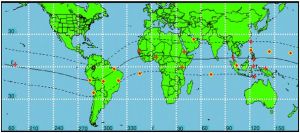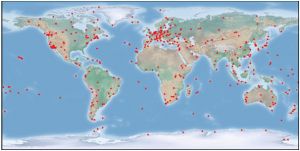January 22, 2020
Many Space agencies across the globe have launched satellites in particular to observe and understand the changes happening on the surface of the sun. Many instruments specifically for measuring various parameters have been orbited through these space agencies. To understand the dynamics of Sun and the related activities and to derive the affects of these activities on our daily life is the main goal of research carried out by many space agencies & their mission. NASA has dedicated a centre named Space Weather Prediction Centre (SWPC) for maintaining a real time data centre for measuring certain parameters and predicting the occurrence of extreme events. A database of real time monitoring is being updated on their website for every 15minutes. A few agencies have dedicated their work to examine the effect of these solar activities on ‘Interplanetary Magnetic Field’ (IMF) and Geomagnetism of Earth.
Similarly, the Air Force Research Laboratory of USA has established Scintillation Network and Decision Aid (SCINDA), as a set-up of ground based stations that monitor trans-ionospheric signals at the UHF and L Band frequencies. The main purpose of SCINDA is to serve as regional specification and short term forecasts of scintillation occurring onto UHF and L Band frequencies i.e., especially on communication and navigation signals. These scintillations onto signals are caused due to irregular distribution of electron density across the equatorial ionosphere region.

Image Courtesy : K Groves
The SCINDA station gives information of two eminent parameters namely, S4 (Scintillation Index) and TEC (Total Electron Content), which are the measures of how much signal has undergone modulation during transverse and total number of electrons present in a 1-m2 cross-sectional area between satellite and station respectively. S4 is indicated by values ranging from 0 to 1, where ‘0’ represents no modulation in the signal and ‘1’ being 100% modulated signal. ‘Scintillation’ word is characteristically referred to quick amplitude and phase variations in a received electromagnetic wave. The cause may be diffractive when electromagnetic waves are spread in an asymmetrical medium composed of several little changes in the refractive index. The variations in the intensity of the signal are deliberated by the scintillation intensity index S4. Due to solar activities it is obvious that our ionosphere will expand and become more ionized. Thus the solar activity occurrences and evidences can be correlated with SCINDA network data. Thus severe to extreme events impacts on to TEC and S4 can be realized using these stations data. Also, the diurnal, seasonal and annual variations of TEC can be studied for a specific geographic location by post processing SCINDA data.
GPS datasets can also be freely accessed at International GNSS Service Network
https://www.igscb.org/igs-stations


Image Courtesy : IGS
The author of this blog article is Dr. Rajesh V Chowdhary, Associate Professor, Department of Electronics & Telecommunication, International Institute of Information Technology, (I²IT), Pune (www.isquareit.edu.in) (rajeshv@isquareit.edu.in)

Recent Comments